2020 NISSAN 370Z ECO mode
[x] Cancel search: ECO modePage 378 of 455
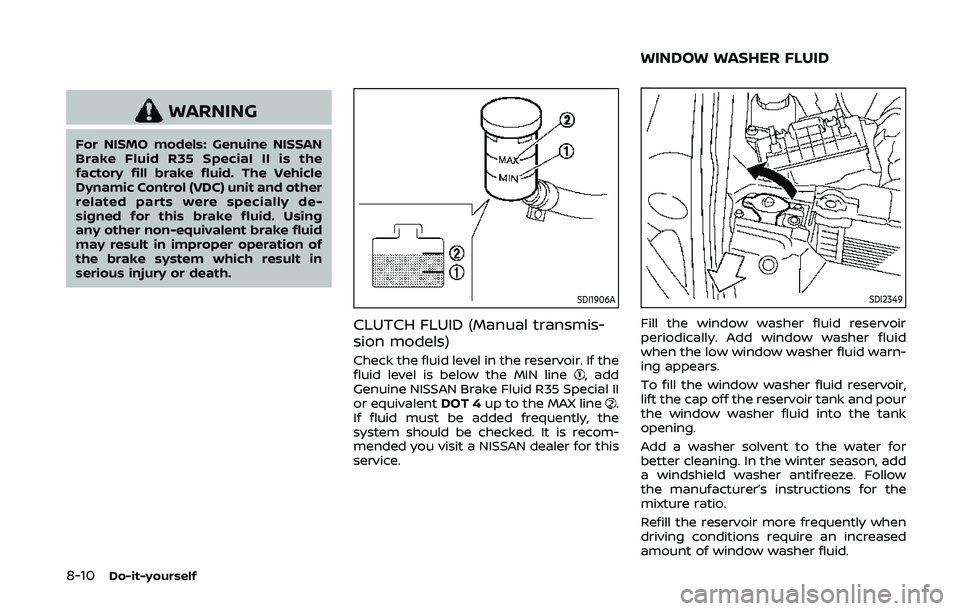
8-10Do-it-yourself
WARNING
For NISMO models: Genuine NISSAN
Brake Fluid R35 Special II is the
factory fill brake fluid. The Vehicle
Dynamic Control (VDC) unit and other
related parts were specially de-
signed for this brake fluid. Using
any other non-equivalent brake fluid
may result in improper operation of
the brake system which result in
serious injury or death.
SDI1906A
CLUTCH FLUID (Manual transmis-
sion models)
Check the fluid level in the reservoir. If the
fluid level is below the MIN line, add
Genuine NISSAN Brake Fluid R35 Special II
or equivalent DOT 4up to the MAX line
.
If fluid must be added frequently, the
system should be checked. It is recom-
mended you visit a NISSAN dealer for this
service.
SDI2349
Fill the window washer fluid reservoir
periodically. Add window washer fluid
when the low window washer fluid warn-
ing appears.
To fill the window washer fluid reservoir,
lift the cap off the reservoir tank and pour
the window washer fluid into the tank
opening.
Add a washer solvent to the water for
better cleaning. In the winter season, add
a windshield washer antifreeze. Follow
the manufacturer’s instructions for the
mixture ratio.
Refill the reservoir more frequently when
driving conditions require an increased
amount of window washer fluid.
WINDOW WASHER FLUID
Page 385 of 455
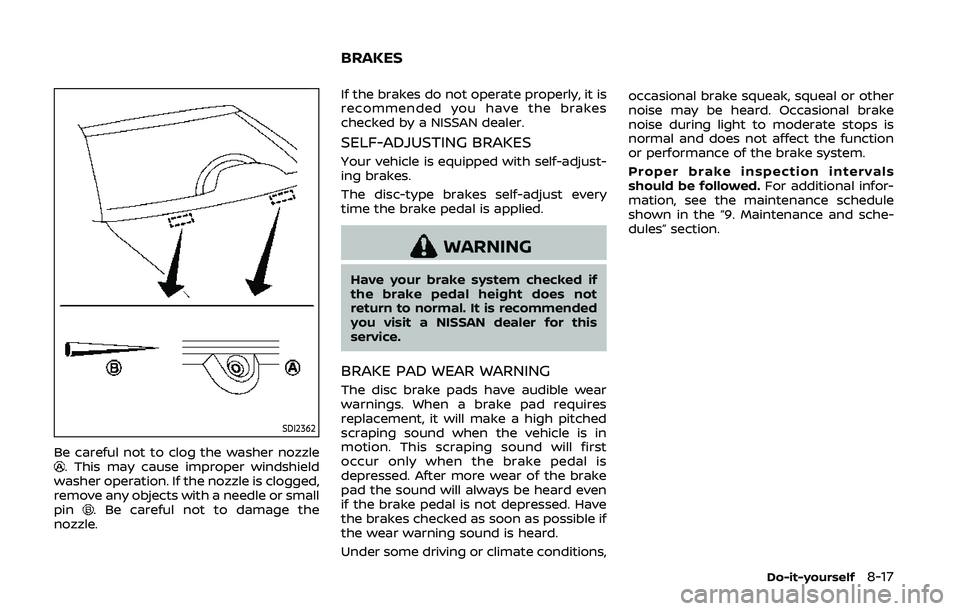
SDI2362
Be careful not to clog the washer nozzle. This may cause improper windshield
washer operation. If the nozzle is clogged,
remove any objects with a needle or small
pin
. Be careful not to damage the
nozzle. If the brakes do not operate properly, it is
recommended you have the brakes
checked by a NISSAN dealer.
SELF-ADJUSTING BRAKES
Your vehicle is equipped with self-adjust-
ing brakes.
The disc-type brakes self-adjust every
time the brake pedal is applied.
WARNING
Have your brake system checked if
the brake pedal height does not
return to normal. It is recommended
you visit a NISSAN dealer for this
service.
BRAKE PAD WEAR WARNING
The disc brake pads have audible wear
warnings. When a brake pad requires
replacement, it will make a high pitched
scraping sound when the vehicle is in
motion. This scraping sound will first
occur only when the brake pedal is
depressed. After more wear of the brake
pad the sound will always be heard even
if the brake pedal is not depressed. Have
the brakes checked as soon as possible if
the wear warning sound is heard.
Under some driving or climate conditions,occasional brake squeak, squeal or other
noise may be heard. Occasional brake
noise during light to moderate stops is
normal and does not affect the function
or performance of the brake system.
Proper brake inspection intervals
should be followed.
For additional infor-
mation, see the maintenance schedule
shown in the “9. Maintenance and sche-
dules” section.
Do-it-yourself8-17
BRAKES
Page 387 of 455

SDI2361
PASSENGER COMPARTMENT
WARNING
Never use a fuse of a higher or lower
amperage rating than that specified
on the fuse box cover. This could
damage the electrical system or
electronic control units or cause a
fire.
If any electrical equipment does not
operate, check for an open fuse.
1. Be sure the ignition switch is pushed to the OFF or LOCK position and the headlight switch is turned to OFF.
2. Open the fuse box lid.
3. Remove the fuse with the fuse puller
.
4. If the fuse is open, replace it with a new fuse. Spare fuses are stored in the
fuse box.
5. If a new fuse also opens, have the electrical system checked and re-
paired. It is recommended you visit a
NISSAN dealer for this service.
SDI2704
Extended storage fuse switch
To reduce battery drain, the extended
storage fuse switch comes from the
factory switched off.
Prior to delivery of your vehicle, the switch
is pushed in (switched on) and should
always remain on.
If the extended storage fuse switch is not
pushed in (switched on), the “SHIPPING
MODE ON, PUSH STORAGE FUSE” warning
may appear on the vehicle information
display. See “Warnings and alerts” (P.2-22).
If any electrical equipment does not
operate, remove the extended storage
fuse switch and check for an open fuse.
Do-it-yourself8-19
Page 394 of 455
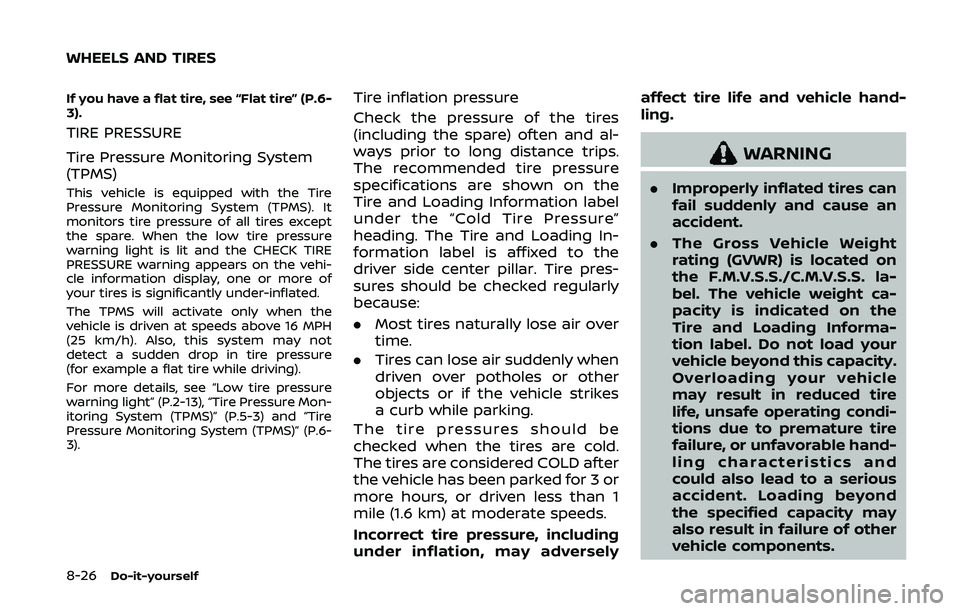
8-26Do-it-yourself
If you have a flat tire, see “Flat tire” (P.6-
3).
TIRE PRESSURE
Tire Pressure Monitoring System
(TPMS)
This vehicle is equipped with the Tire
Pressure Monitoring System (TPMS). It
monitors tire pressure of all tires except
the spare. When the low tire pressure
warning light is lit and the CHECK TIRE
PRESSURE warning appears on the vehi-
cle information display, one or more of
your tires is significantly under-inflated.
The TPMS will activate only when the
vehicle is driven at speeds above 16 MPH
(25 km/h). Also, this system may not
detect a sudden drop in tire pressure
(for example a flat tire while driving).
For more details, see “Low tire pressure
warning light” (P.2-13), “Tire Pressure Mon-
itoring System (TPMS)” (P.5-3) and “Tire
Pressure Monitoring System (TPMS)” (P.6-
3).
Tire inflation pressure
Check the pressure of the tires
(including the spare) often and al-
ways prior to long distance trips.
The recommended tire pressure
specifications are shown on the
Tire and Loading Information label
under the “Cold Tire Pressure”
heading. The Tire and Loading In-
formation label is affixed to the
driver side center pillar. Tire pres-
sures should be checked regularly
because:
.Most tires naturally lose air over
time.
. Tires can lose air suddenly when
driven over potholes or other
objects or if the vehicle strikes
a curb while parking.
The tire pressures should be
checked when the tires are cold.
The tires are considered COLD after
the vehicle has been parked for 3 or
more hours, or driven less than 1
mile (1.6 km) at moderate speeds.
Incorrect tire pressure, including
under inflation, may adversely affect tire life and vehicle hand-
ling.
WARNING
.
Improperly inflated tires can
fail suddenly and cause an
accident.
. The Gross Vehicle Weight
rating (GVWR) is located on
the F.M.V.S.S./C.M.V.S.S. la-
bel. The vehicle weight ca-
pacity is indicated on the
Tire and Loading Informa-
tion label. Do not load your
vehicle beyond this capacity.
Overloading your vehicle
may result in reduced tire
life, unsafe operating condi-
tions due to premature tire
failure, or unfavorable hand-
ling characteristics and
could also lead to a serious
accident. Loading beyond
the specified capacity may
also result in failure of other
vehicle components.
WHEELS AND TIRES
Page 396 of 455

8-28Do-it-yourself
SDI2462
Tire and Loading Information label
Seating capacity: The max-
imum number of occu-
pants that can be seated
in the vehicle.
Vehicle load limit: See “Ve-hicle loading information”
(P.10-19).
Original size: The size of
the tires originally installed
on the vehicle at the fac-
tory.
Cold tire pressure: Inflate
the tires to this pressure
when the tires are cold.
Tires are considered COLD
after the vehicle has been
parked for 3 or more hours,
or driven less than 1 mile
(1.6 km) at moderate
speeds. The recommended
cold tire inflation is set by
the manufacturer to pro-
vide the best balance of
tire wear, vehicle handling,
driveability, tire noise, etc.,
up to the vehicle’s GVWR.
Tire size — see “Tire label-
ing” (P.8-30).
Spare tire size or compact
spare tire size (if so
equipped)
Page 398 of 455
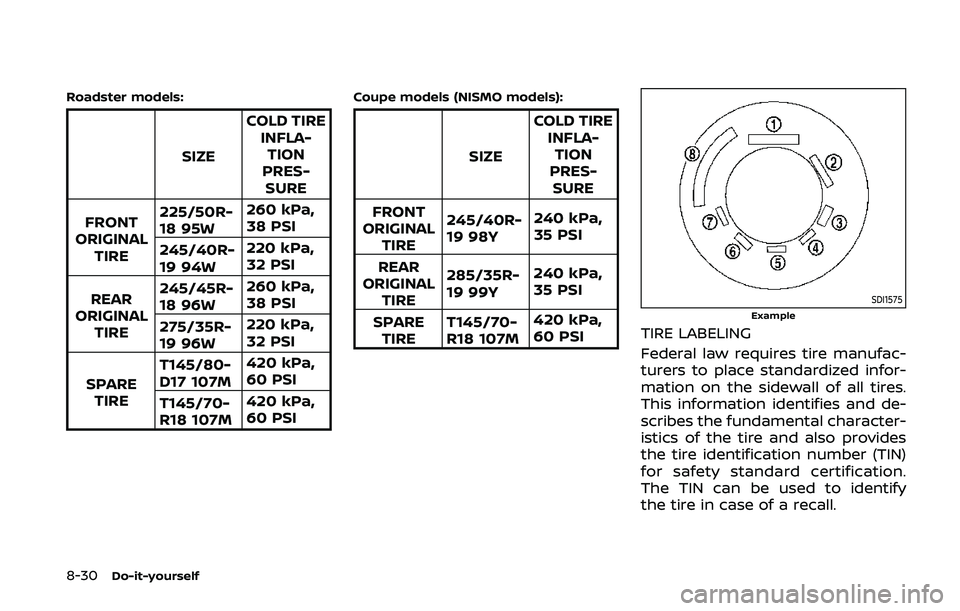
8-30Do-it-yourself
Roadster models:
SIZECOLD TIRE
INFLA-TION
PRES-
SURE
FRONT
ORIGINAL
TIRE 225/50R-
18 95W
260 kPa,
38 PSI
245/40R-
19 94W 220 kPa,
32 PSI
REAR
ORIGINAL
TIRE 245/45R-
18 96W
260 kPa,
38 PSI
275/35R-
19 96W 220 kPa,
32 PSI
SPARE TIRE T145/80-
D17 107M
420 kPa,
60 PSI
T145/70-
R18 107M 420 kPa,
60 PSI
Coupe models (NISMO models):
SIZECOLD TIRE
INFLA-TION
PRES-
SURE
FRONT
ORIGINAL TIRE 245/40R-
19 98Y
240 kPa,
35 PSI
REAR
ORIGINAL
TIRE 285/35R-
19 99Y
240 kPa,
35 PSI
SPARE TIRE T145/70-
R18 107M 420 kPa,
60 PSI
SDI1575Example
TIRE LABELING
Federal law requires tire manufac-
turers to place standardized infor-
mation on the sidewall of all tires.
This information identifies and de-
scribes the fundamental character-
istics of the tire and also provides
the tire identification number (TIN)
for safety standard certification.
The TIN can be used to identify
the tire in case of a recall.
Page 401 of 455
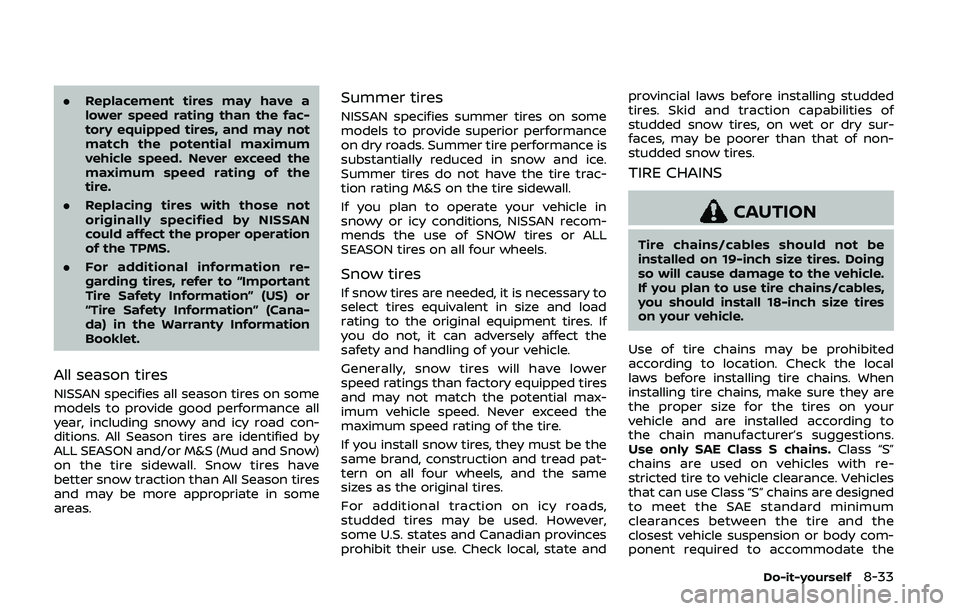
.Replacement tires may have a
lower speed rating than the fac-
tory equipped tires, and may not
match the potential maximum
vehicle speed. Never exceed the
maximum speed rating of the
tire.
. Replacing tires with those not
originally specified by NISSAN
could affect the proper operation
of the TPMS.
. For additional information re-
garding tires, refer to “Important
Tire Safety Information” (US) or
“Tire Safety Information” (Cana-
da) in the Warranty Information
Booklet.
All season tires
NISSAN specifies all season tires on some
models to provide good performance all
year, including snowy and icy road con-
ditions. All Season tires are identified by
ALL SEASON and/or M&S (Mud and Snow)
on the tire sidewall. Snow tires have
better snow traction than All Season tires
and may be more appropriate in some
areas.
Summer tires
NISSAN specifies summer tires on some
models to provide superior performance
on dry roads. Summer tire performance is
substantially reduced in snow and ice.
Summer tires do not have the tire trac-
tion rating M&S on the tire sidewall.
If you plan to operate your vehicle in
snowy or icy conditions, NISSAN recom-
mends the use of SNOW tires or ALL
SEASON tires on all four wheels.
Snow tires
If snow tires are needed, it is necessary to
select tires equivalent in size and load
rating to the original equipment tires. If
you do not, it can adversely affect the
safety and handling of your vehicle.
Generally, snow tires will have lower
speed ratings than factory equipped tires
and may not match the potential max-
imum vehicle speed. Never exceed the
maximum speed rating of the tire.
If you install snow tires, they must be the
same brand, construction and tread pat-
tern on all four wheels, and the same
sizes as the original tires.
For additional traction on icy roads,
studded tires may be used. However,
some U.S. states and Canadian provinces
prohibit their use. Check local, state and provincial laws before installing studded
tires. Skid and traction capabilities of
studded snow tires, on wet or dry sur-
faces, may be poorer than that of non-
studded snow tires.
TIRE CHAINS
CAUTION
Tire chains/cables should not be
installed on 19-inch size tires. Doing
so will cause damage to the vehicle.
If you plan to use tire chains/cables,
you should install 18-inch size tires
on your vehicle.
Use of tire chains may be prohibited
according to location. Check the local
laws before installing tire chains. When
installing tire chains, make sure they are
the proper size for the tires on your
vehicle and are installed according to
the chain manufacturer’s suggestions.
Use only SAE Class S chains. Class “S”
chains are used on vehicles with re-
stricted tire to vehicle clearance. Vehicles
that can use Class “S” chains are designed
to meet the SAE standard minimum
clearances between the tire and the
closest vehicle suspension or body com-
ponent required to accommodate the
Do-it-yourself8-33
Page 421 of 455

10 Technical and consumer information
Capacities and
recommended fluids/lubricants .................................... 10-2Fuel information .................................................................. 10-4
Engine oil and oil filter recommendation ........ 10-7
Air conditioning system refrigerant and
lubricant recommendations ...................................... 10-8
Specifications ........................................................................\
........ 10-9 Engine ........................................................................\
.................. 10-9
Wheels and tires .............................................................. 10-10
Dimensions ........................................................................\
.. 10-11
When traveling or registering in
another country ..................................................................... 10-12
Vehicle identification .......................................................... 10-12 Vehicle Identification Number
(VIN) plate ........................................................................\
...... 10-12
Vehicle identification number
(chassis number) ............................................................. 10-12
Engine serial number ................................................... 10-13
F.M.V.S.S./C.M.V.S.S. certification label ............. 10-13
Emission control information label .................. 10-13
Tire and Loading Information label ................. 10-14
Air conditioner specification label ..................... 10-14
Installing front license plate ......................................... 10-15
Except for NISMO models ........................................ 10-15
For NISMO models ......................................................... 10-17 Removing air deflectors (except for
NISMO models) ........................................................................\
10-18
Vehicle loading information ......................................... 10-19
Terms ........................................................................\
............. 10-19
Vehicle load capacity ................................................ 10-20
Loading tips ...................................................................... 10-21
Measurement of weights ....................................... 10-21
Towing a trailer ...................................................................... 10-22
Flat towing ........................................................................\
......... 10-22 Automatic transmission .......................................... 10-22
Manual transmission ................................................. 10-22
Uniform tire quality grading ........................................ 10-23 Treadwear ........................................................................\
.. 10-23
Traction AA, A, B and C ........................................... 10-23
Temperature A, B and C ......................................... 10-23
Emission control system warranty ......................... 10-24
Reporting safety defects ................................................ 10-24
Readiness for Inspection/Maintenance
(I/M) test ........................................................................\
............... 10-25
Event Data Recorders (EDR) ......................................... 10-25
Owner’s Manual/Service Manual
order information ................................................................. 10-26